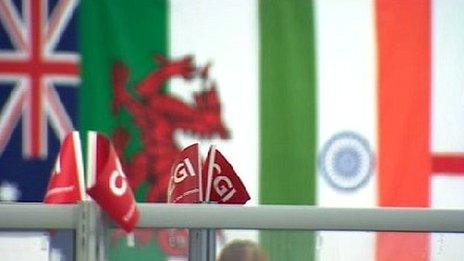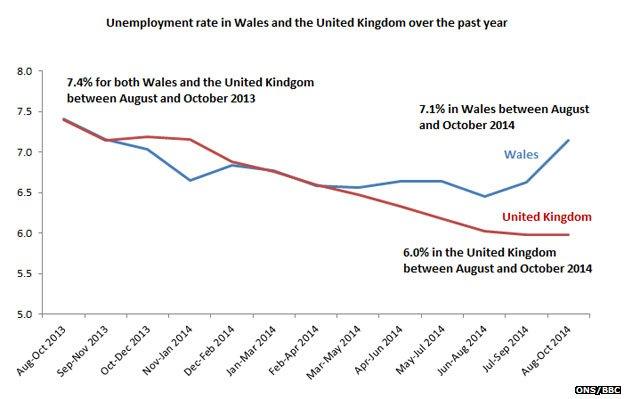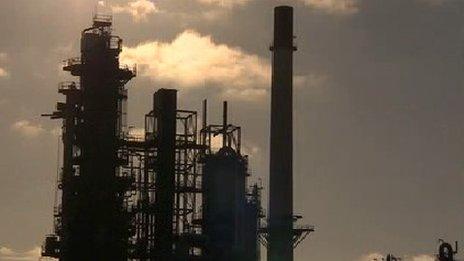2014 review: How is the Welsh economy doing?
- Published

CGI created more than 600 jobs at its call centre in Bridgend
The year 2014 has been lively for those who watch the Welsh economy.
In some ways the economic landscape of Wales is very similar to 12 months ago; in other ways there have been big changes.
I have met some fantastically dynamic individuals and looked at great projects with the potential to drive the Welsh economy forward.
But I have also met others who are trapped in poverty because of the low-skilled, low-wage economy that Wales seems to struggle to move away from.

HOW CAN WALES MAKE MORE MONEY ?
BBC Wales economics correspondent Sarah Dickins says the Welsh economy is driving faster - but is still behind in the race
The measurement that shows the value of what we all make and produce (Gross Value Added - GVA) showed that once again Wales is at the bottom of the pack.
In 2013, we saw the largest proportion of economic growth of any other part of the UK - as we did in 2012. But this has still not generated enough money to lift us from the bottom.
June 2014: 15 years on, had devolution brought swings and roundabouts for the Welsh economy?
June 2014 - 15 years after devolution - seemed like a good time to see how the Welsh economy had changed since some power had been devolved.
Other proposals to help the economy have moved forward, for example the Cardiff Capital City Region, the Swansea Bay City Region and Wales has been granted another tranche of money to help lift west Wales and the valleys from being one of the poorest part of the European Union.

WHICH INDUSTRY IS GROWING THE FASTEST ?
The Welsh government has identified industries which it believes have most potential to grow.
So of those priority sectors, as they call them, which is growing at the fastest pace?
You may be surprised to know it is the creative sector: a wide group of industries from film and television to gaming and software design.
In Wales in 2014 more people joined that group of businesses than any other sector and it is something we are becoming known for.

JOBS - THEY'VE COME AND GONE
SPTS Technologies is creating 30 new posts in Newport - but that is just part of the picture
Unemployment levels have for decades been a highly used measurement of the health of our economy and used frequently by politicians.
Interestingly, this year AMs and MPs have increasingly talked about employment levels, saying more people are working in the UK and in Wales.
In reality, many new jobs - and jobs lost - happen away from the glare of publicity but others are in the headlines either because of the number of people involved or because of their particular significance.
Here are three sets of job losses that hit Wales:
Avana, Rogerstone, Newport: The bakery lost its contract to supply cakes to Marks and Spencer threatening the future for 650 jobs - a body blow to the area.
Murco refinery, Pembrokeshire: The hoped-for sale broke down in November and it became clear that refining would come to an end there. Around 600 people work there either directly or as contractors and the refinery injects £90 million into the local economy.
Dairy Crest, Whitland, Carmarthenshire: Some losses have a significance beyond pure employment. When Dairy Crest closed its milk processing plant it left Tomlinsons in Wrexham as the only Welsh dairy supplying supermarkets with Welsh milk. The rest travels from farms to England to be processed and then comes back to Wales.
But jobs came too - with cyber security firm Alert Logic opening its UK headquarters in Cardiff, while Canadian firm CGI created more than 600 jobs in Bridgend.
And on the eve of the UK Investment Summit in Newport a host of new jobs packages were unveiled.

WORKING BUT STRUGGLING WITH THE BILLS
The phrase the "working poor" became more common place as the year went on amongst economy-watchers and politicians as the arguments continued about the cost of living and whether people were better or worse off.
In June, the Wales TUC published a report saying the Welsh economy would be more than £150 million a year better off if low paid workers were paid a living wage of £7.45 an hour.
It argued the change would boost tax revenues, while reducing the amount paid out in means tested benefits and tax credits.
Sarah Dickins visits Hydro Industries in Carmarthenshire, which is expanding
Unemployment in Wales has been interesting to watch this year. As 2014 started unemployment rates in the UK and Wales were both falling steeply.
Then the statistics published by the Office for National Statistics in the spring showed that Wales had lower rates of unemployment than the UK average, something that happened for a long time.

But since then unemployment in Wales seems to have increased whereas it has not in the UK.
The latest figures published on 17 December showed another rise in unemployment in Wales, by 8,000, taking the rate to 7.1%. In the UK it stands at 6%.
It also revealed that Wales was the only part of the UK where there were fewer people working between August and October, compared with the same period 12 months earlier. In fact, 41,000 fewer.
And within Wales there are very different experiences of the economy in different communities.
The Wales Index of Multiple Deprivation looks at a wide variety of factors including employment, skills, housing and health to determine where the most deprived communities in Wales are.
And if after all that you are seeking inspiration - one scheme trying to help younger people into work was certainly memorable.
The trainees now face the challenge of getting a job
The Lift programme ran a pilot project in Tredegar at the local fire station - it started in the gym and then led to long-term unemployed people working together and building self-confidence as they looked to find out how to work out in the world.
- Published23 December 2014
